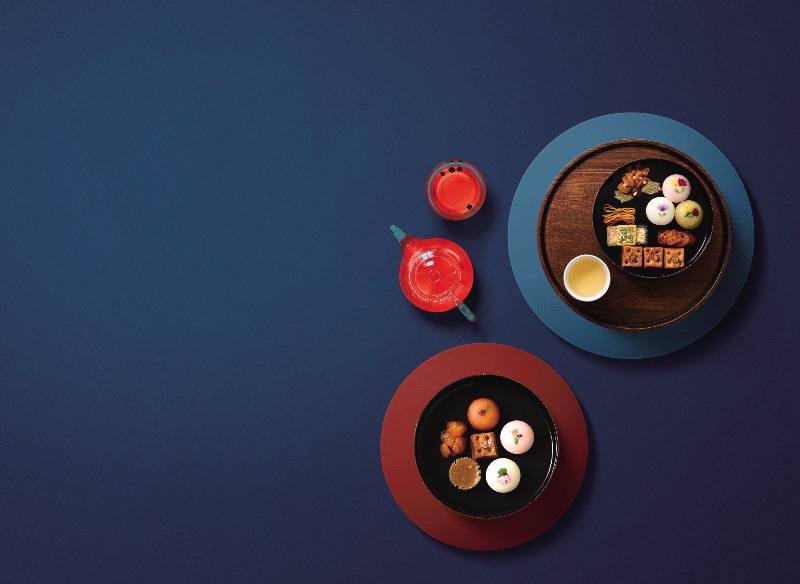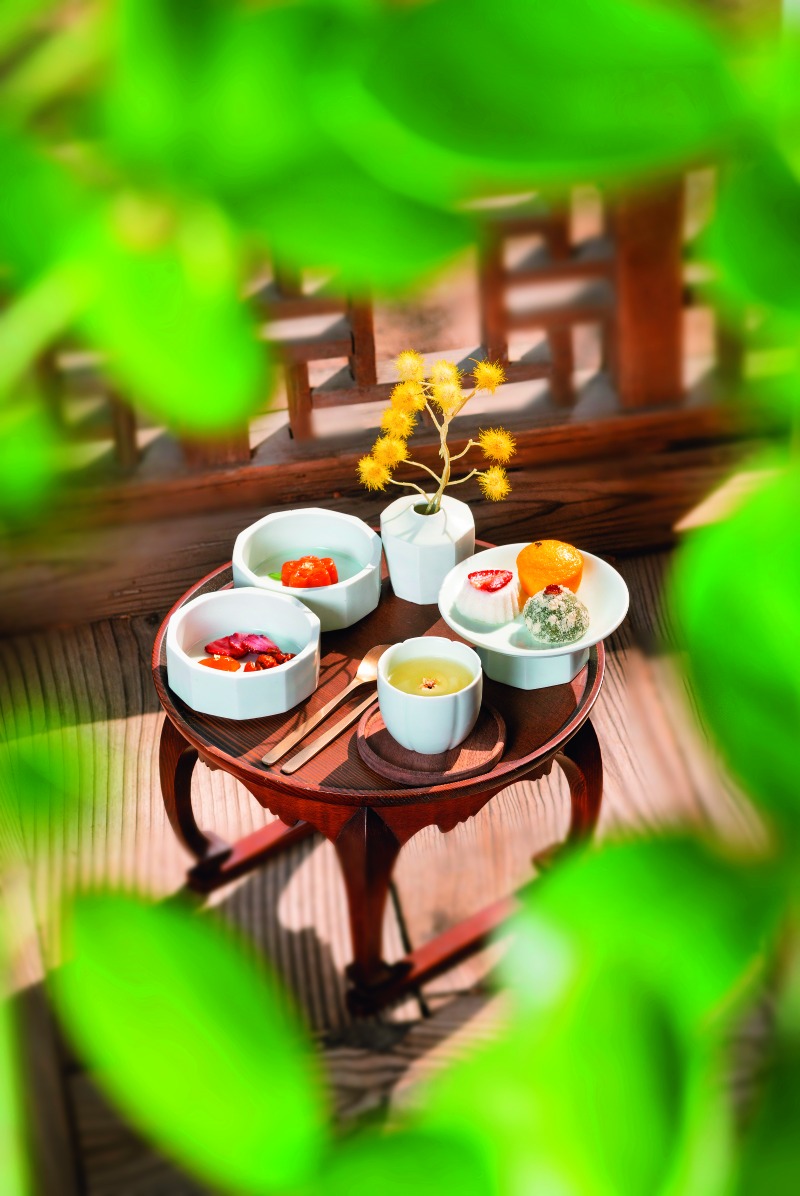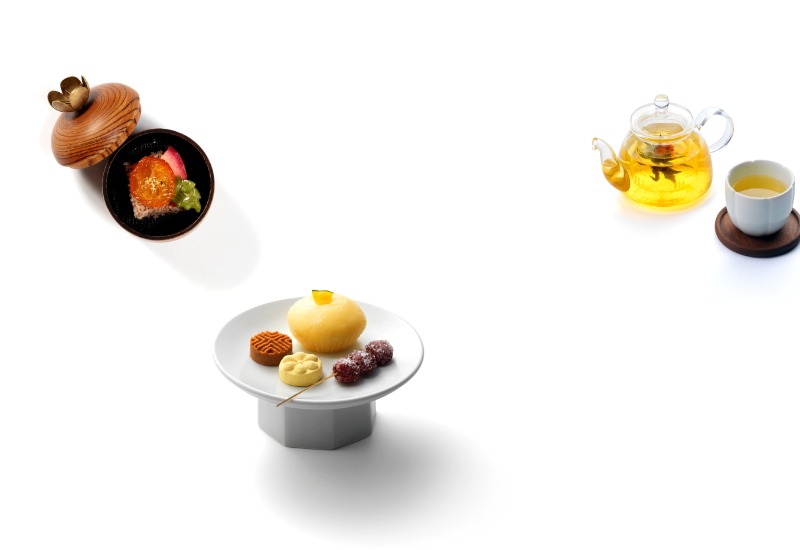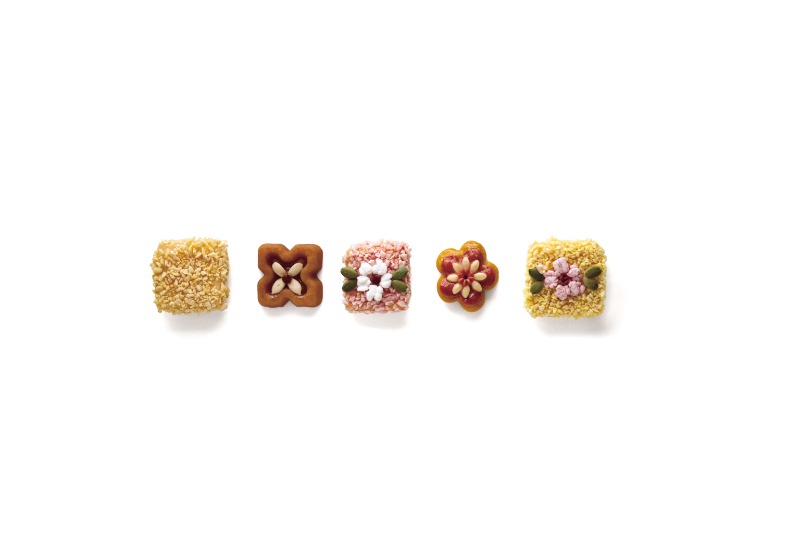The court cuisine of the Joseon Dynasty was officially recognized as National Intangible Cultural Heritage in 1971. Designed to please the refined palates of royalty, it was prepared with utmost care using only the freshest seasonal ingredients.

Hwajeon, yakgwa, and jeonggwa are among the snacks served at Gyeongbok Palace’s Saenggwabang Program. Organized by the Cultural Heritage Administration’s Royal Palaces and Tombs Center alongside the Korea Cultural Heritage Foundation, the event is held once every spring and fall and allows visitors to taste different kinds of traditional palace snacks and refreshments.
© Korea Cultural Heritage Foundation
During the Joseon Dynasty, Samjinnal, the third day of the third lunar month, was a festive occasion celebrating the arrival of spring. Usually confined to their homes, women were given rare permission to go out on that day. Venturing outdoors to a scenic spot, they would make hwajeon, pan-fried rice cakes adorned with purple azalea petals. The royal family also celebrated this special day with a ceremony called hwajeon nori, in which the queen went out into the palace gardens with her servants to handpick the azaleas that would be used to make the tasty treat.
While seasonal dishes like hwajeon were meant to be enjoyed outdoors on special occasions, the majority of royal court cuisine was prepared inside the various kitchens located on palace grounds. While Sojubang was the kitchen where the king’s meals were prepared on a daily basis, Saenggwabang was dedicated to the preparation of desserts and refreshments. Since rice cakes and other snacks played a vital role in bringing a sense of opulence to the royal banquets, the palace maids assigned to this part of the royal kitchen took particular care in preparing these delicacies.
Rice Cakes Galore

The royal snack table for one person offered in 2021 at the Korea House Kohojae, a cultural space in Pil-dong in downtown Seoul.
© KOREA HOUSE
One type of rice cake that was served at major events such as the king’s birthday or royal banquets was the highly prized duteoptteok. Recipes for this treat, which is rather complicated to make, can be found in ancient s about royal banquet foods. First, soy sauce and honey are combined with glutinous rice flour, then the mixture is placed in a steamer one spoonful at a time, leaving sufficient space between each piece. Next, the pieces are topped with a combination of finely chopped chestnuts, jujubes, and yuzu and rolled into a little ball with red bean powder. The balls are sprinkled with more glutinous rice flour and red bean powder and finally steamed. Highly nutritious, these delicious rice cakes with a mound-like shape have a fragrant aroma and an enjoyable texture which is enhanced by the chewy pieces of yuzu.
Another regular fixture at royal banquets was yaksik, a snack with a history of more than 1,500 years. Freshly steamed glutinous rice is seasoned with honey, sesame oil, and soy sauce, to which chestnuts, jujubes, and pine nuts are added before the resulting rice mixture is steamed once more. Though rice cakes are typically pounded with a mallet to give them their sticky consistency, yaksik maintains the texture of cooked rice. Jeungpyeon, made with rice flour and makgeolli, a fermented rice wine, was popular in summer because it would not easily spoil. The yeast in the makgeolli causes the dough to rise, giving the rice cake a fluffy texture. The tangy notes and fragrant aroma of the makgeolli combine with the sweetness of the rice to give jeungpyeon its signature taste. It is often garnished with flower petals, chestnuts, jujubes, or pine nuts.

(L)
Guseonwangdogo, which includes nine different medicinal herbs, purportedly helped protect the stomach, improve digestion, and replenish the body’s energy. This special type of rice cake was enjoyed by many Joseon Dynasty monarchs, including the illustrious King Sejong.
© Korea Cultural Heritage Foundation
(M)
Pumpkin jungpyeon, raspberry jeonggwa, and dasik made from soy flour and pine pollen were part of the 2022 summer menu served at the Korea House Kohojae.
© KOREA HOUSE
(R)
Belonging to the chrysanthemum family, safflower is mainly known for its seeds, which are used to make cooking oil. In Korea, however, the flowers have long been used to make a tea considered beneficial for women in alleviating arthritis pain.
© KOREA HOUSE
Made with nine different medicinal herbs, guseonwangdogo was thought to restore balance and harmony to the body in the same way a wise king brings peace and order to his kingdom. The recipe was devised by a palace physician for King Sejong (r. 1418–1450), who suffered from a number of health issues such as diabetes and neuralgia due to being overweight and under constant stress in carrying out his royal duties. The rice cakes contain barley malt and have a subtle sweetness thanks to the use of dried persimmon powder, which also made them more palatable to a king who could not tolerate the bitter taste of ordinary herbal decoctions. Dried under the sun and ground into a fine powder, guseonwangdogo was also used to make rice porridge or mixed with honey water toa sweet drink.
Then there is gaeseong juak, a type of rice cake served at weddings in the Kaesong region of Hwanghae Province, which gained such acclaim that it was elevated to the status of a royal court delicacy. The recipe involves mixing glutinous and non-glutinous rice powders together with makgeolli to make a dough which is then shaped into round, flat cakes that are pan-fried in oil and finally coated with honey or rice syrup for a glossy finish. These rice cakes were often served to esteemed guests at the palace due to their pleasing, round shape, reminiscent of small tangerines. Crispy and sweet on the outside, soft and chewy on the inside, they were loved for their taste and texture.
From the Palace to Ordinary Homes
After rice cakes, sweet confections called gwaja were the second most popular type of snack at the royal court. Dasik, a type of cookie eaten with tea, was widely enjoyed among everyone regardless of status, both inside and outside of the palace. The cookies were made with a mixture of grain powder and finely ground medicinal herbs kneaded into a dough with honey, before being pressed into a special mold to give them their distinctive shapes. When tea drinking became more widespread during the Goryeo Dynasty (918–1392), dasik started to be served with tea at ceremonial gatherings and banquets. Molds engraved with Chinese characters and various other patterns were used to imprint each cookie with a symbolic design representing health, longevity, or other auspicious wishes. Historical records indicate that new dasik molds were d especially for the wedding banquet of King Yeongjo (r. 1724–1776) and his second wife, Queen Jeongsun.
Equally as popular as dasik was yakgwa, a type of cookie made from a dough consisting of wheat flour, sesame oil, and honey, which is fried and then soaked in honey. Yakgwa was so delicious that it quickly spread beyond the palace into ordinary households. However, due to the high cost of its ingredients, making yakgwa was once banned to prevent it from becoming a burden on the citizenry.
Another traditional snack is suksilgwa, made by boiling down in honey a mixture of cooking fruits, nuts, and roots such as chestnuts, jujubes, and ginger. There are two types of suksilgwa — one is made by cooking the ingredients whole to avoid altering their original shapes, and the other by mashing up cooked ingredients and boiling them down in sugar or honey until the mixture reaches a thick consistency and can be molded back into those same original shapes. Being soft and easy on the stomach, suksilgwa was popular not only at royal banquets but also at aristocratic weddings and 60th birthday celebrations.
Even some medicinal ingredients were turned into delicious treats. A prime example is insam jeonggwa, which is made by lightly steaming ginseng in order to get rid of its bitter taste, before adding it to honey or rice syrup and leaving it to boil down over low heat for an extended period of time until it becomes sweet and chewy. King Yeongjo, who lived to the ripe old age of 81, was said to be particularly fond of ginseng. However, despite his love for the delicacy he emphasized frugality and limited the amount of insam jeonggwa used in ancestral rites.

The popularity of royal snacks such as yugwa and yakgwa spread beyond the palace walls into ordinary households.
© Shutterstock
Refreshing Summer Drinks
Rice cakes and other snacks would always be accompanied by drinks. Jehotang, for example, was a summer beverage served at the palace on the traditional Dano holiday on the fifth day of the fifth lunar month. It is made with dried skinless plums, black cardamom, and other medicinal ingredients ground into a fine powder, mixed with honey, and then heated to make a syrup that can be stirred into cold water and enjoyed as a refreshing beverage. Considered the ultimate thirst quencher, jehotang was made at Naeuiwon, the palace pharmacy, and presented to the king, who bestowed it upon elderly officials along with a fan as a symbolic gesture.
Another well-liked summer drink was omija tea, known for its sweet and sour taste and distinctive red color. Omija, which literally translates as “five-flavored berry,” is said to have a sweet, bitter, sour, salty, and spicy taste. The tea is made by infusing the berries in cold water, which is then sweetened with honey. It can also be turned into hwachae, a sort of punch, by adding thin slices of pear. Records show that King Jungjong (r.1488–1544) had a palace physician prepare him omija tea to help quench his thirst after complaining that he was too hot.
Hwachae, made from either honey or omija-infused water, to which fruits and flower petals were added just before serving, was meant to be enjoyed chilled during the summer months. A popular version is yuja hwachae, which is honey water with thinly sliced pear and yuzu, and a topping of pomegranate arils and pine nuts. Refreshing and fragrant with a citrusy smell, yuja hwachae often appears in records of royal banquets that state it was served to royalty, envoys, and court officials.
Among the many traditional Korean drinks, sikhye stands out as a favorite. It is made by adding rice to water mixed with barley malt, which is then left to ferment. This process results in a sweet drink given a refreshing zing with the addition of ginger. The malt contains diastase enzymes that benefit digestion and promote a healthy gut. Variations of sikhye are made with ginseng, pumpkins, and lotus leaves.
Yoon Sook-ja CEO of the Institute of Traditional Korean Food